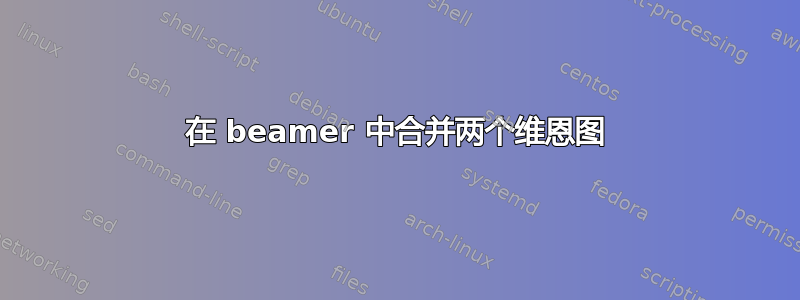
我对 LaTeX 和 Beamer 比较熟悉,但对 TikZ 环境却完全陌生。我创建了两个维恩图,如下所示:
\documentclass{beamer}
\usepackage[utf8]{inputenc}
\usepackage[T1]{fontenc}
\usepackage{lmodern}
\usepackage[french]{babel}
\usepackage[absolute,overlay]{textpos}
\usepackage{tikz}
\begin{document}
\begin{frame}
\begin{textblock*}{1.5cm}(0.1cm,0.2cm) % {block width} (coords)
\begin{tikzpicture}
\begin{scope}[blend group = soft light]
\fill[red!30!white] ( 90:1.2) circle (2);
\fill[green!30!white] (210:1.2) circle (2);
\fill[blue!30!white] (330:1.2) circle (2);
\end{scope}
\node at ( 90:2) {Élaboration};
\node at (-1.5,-0.97) {Fonctionnalisation};
\node at ( 330:2) {\underline{Caractérisation}};
\node [font=\Large] {LMPT};
\end{tikzpicture}
\end{textblock*}
\begin{textblock*}{1.5cm}(6.6cm,0.2cm) % {block width} (coords)
\begin{tikzpicture}
\begin{scope}[blend group = soft light]
\fill[red!60!white] ( 90:1.2) circle (2);
\fill[green!60!white] (210:1.2) circle (2);
\fill[blue!60!white] (330:1.2) circle (2);
\end{scope}
\node at ( 90:2) {Pluridisciplinarité};
\node at (-1.5,-0.98) {Expérience};
\node at ( 330:2) {Techniques};
\node [font=\Large] {Moi};
\end{tikzpicture}
\end{textblock*}
\end{frame}
\end{document}
问题:
- 如何在两个维恩图下方添加一个框,并带有指向该框的箭头,该框将两个维恩图结合在一起并包含文本?
- 如何将文本添加成两行?
- 我怎样才能摆脱
textblock环境? - 可以加动画吗?就是先出现左图,然后是右图,最后是问题(1)的框。
这些是基本问题,但我也很感激任何其他建议,以使这个特定的框架更加美观。
为了完整起见,我提供了找到维恩图原始代码的链接: http://www.texample.net/tikz/examples/venn/
答案1
我认为有几种方法可以做到这一点。下面我将所有内容移到一个 中tikzpicture。常规叠加命令beamer,如\only和也适用于此处,因此您可以将它用于第 4 点。第 1 点是通过在图表末尾\uncover添加一个新 来完成的,因为所有内容都在一个 中,所以您不需要。对于第 3 点,我想您的意思是\nodetikzpicturetextblockTikZ 节点中的手动/自动换行和文本对齐
三张幻灯片中的第三张如下所示:
\documentclass{beamer}
\usepackage[utf8]{inputenc}
\usepackage[T1]{fontenc}
\usepackage{lmodern}
\usepackage[french]{babel}
\usepackage{tikz}
\begin{document}
\begin{frame}
\begin{tikzpicture}[scale=0.9]
\uncover<1->{
\begin{scope}[blend group = soft light]
\fill[red!30!white] ( 90:1.2) circle (2);
\fill[green!30!white] (210:1.2) circle (2);
\fill[blue!30!white] (330:1.2) circle (2);
\end{scope}
\node at ( 90:2) {Élaboration};
\node at (-1.5,-0.97) {Fonctionnalisation};
\node at ( 330:2) {\underline{Caractérisation}};
\node [font=\Large] {LMPT};
}
\uncover<2->{
\begin{scope}[xshift=6.2cm]
\begin{scope}[blend group = soft light]
\fill[red!60!white] ( 90:1.2) circle (2);
\fill[green!60!white] (210:1.2) circle (2);
\fill[blue!60!white] (330:1.2) circle (2);
\end{scope}
\node at ( 90:2) {Pluridisciplinarité};
\node at (-1.5,-0.98) {Expérience};
\node at ( 330:2) {Techniques};
\node [font=\Large] {Moi};
\end{scope}
}
\uncover<3>{
\node [below=1cm,draw] (txt) at (current bounding box.south) {What is this?};
\draw [stealth-] (txt) -- ++(135:2cm);
\draw [stealth-] (txt) -- ++(45:2cm);
}
\end{tikzpicture}
\end{frame}
\end{document}



